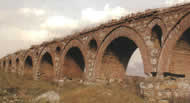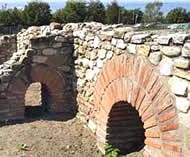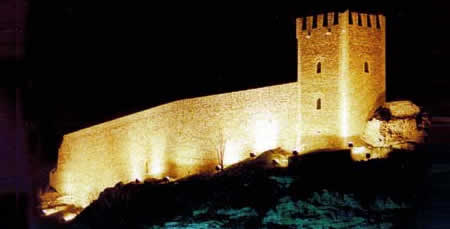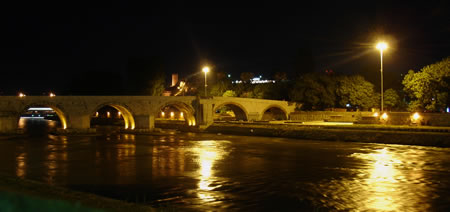  Skopje Aqueduct Skopje Aqueduct
The old aqueduct, built of brick and stone, is located at the end of the Skopje-Kacanik highway and is a monument from the 6th century AD. It supplied the city of Skupi with water from Mount Skopska Crna Gora. Some archaeologists assume that it had 200 arches, 50 of which still remain.
  The Roman settlement SKUPI The Roman settlement SKUPI
Near the Zlokukjani district, one can see the ruins of the Roman settlement SKUPI. The town was located on an important crossroads connecting the Aegean Sea with the Danube region and the Adriatic Sea with Thrace. According to historical data, after the Milan Edict of 313AD Skupi became the seat of the diocese and after 415AD of the archdiocese. Throughout the history, Skupi was often attacked by various barbarian tribes, namely by the Goths in 268 AD and the Huns in the 4th century. Like many other towns in the Balkans, Skupi was flattened by disastrous earthquakes.
After the most ravaging one, the town almost completely died out and its citizens, who were evacuated and saved, chose another location to build their new town.
The town had a rectangular shape and covered a surface of 40 hectares.
Also to see in Skupi: the Basilicas; the Theatre; the Palace
Skopje Fortress - Kale

Kale (Turkish for fortress) had its first walls built on the very same place in the beginning of the 6th century. Archaeological digs have shown that back then materials were taken from the town of Skupi, which was ravished by the 518 earthquake, to build the basis of the fortress. Nowadays the fortress is a remarkable park promenade, with landscaped pathways.
Stone Bridge

The Stone Bridge, which is the symbol of the city, connects the two banks of the river Vardar. It is the most direct link between the old and the new part of the city. According to some Turkish sources, the bridge was built in the second half of the 15th century, during the rule of Sultan Mehmed II, but the latest research from 1990 shows that it was built of well processed stone blocks during the rule of Tsar Yustinian. This bridge is in the centre of the city and stands as a symbol of the inevitable connection between the old and new tradition.
Feudal Tower
Outside the main entrance of the Army Club is the Feudal Tower. It is one of the oldest buildings on the left side of the river Vardar. Until today, no accurate data have been found to indicate when it was built, but supposedly it dates from the end of 18th century. The 14-meter-high tower has a ground floor and three more storeys. The earthquake of 1963 almost ruined it, but it was rebuilt and its remains were framed into the complex of the Army Club. Mother Theresa’s memorial room is on the ground floor of the Feudal Tower.
back |